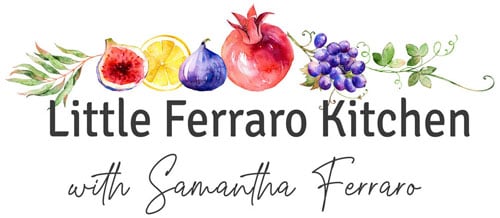A twist on the popular Italian dish, this version of chicken saltimbocca with Speck and Herbes de Provence we bring you pounded chicken cutlets with aromatic herbes de Provence, smoky speck and fresh basil that is finished in a light white wine sauce. Godre, in italian that translates to "enjoy, be delighted, take delight".

Not So Traditional Chicken Saltimbocca
I had fun creating this twist on the classic Italian recipe. Traditionally, saltimbocca is made with veal cutlets, but are difficult to find.
More common is chicken saltimbocca, and with tradition, is made with sage leaves and prosciutto.
My version of chicken saltimbocca offers a bit of French inspiration and in my opinion, more bold flavors. The chicken cutlets are seasoned with aromatic herbes de Provence and pressed with fresh basil leaves and a thin sheet of smoky speck. Making for a fantastic weeknight chicken dinner.
Have you Tried Speck?
If you love prosciutto, you may want to look into finding speck, which is usually found right next to it at the grocery store. Speck is a smoked version of prosciutto, same cut and style, but smoked instead of cured.

Chicken with Herbes de Provence
If you haven't tried herbes de Provence, I highly suggest seeking it out. The aroma is intoxicating while being earthy and floral and is a fantastic seasoning to chicken dishes.
The blend of herbes usually includes a combination of dried rosemary, thyme, tarragon, marjoram and oregano. You could also try the herb blend on Julia Child's Chicken with Herbes de Provence in the most lovely cream sauce.
What to Serve with Chicken Saltimbocca
The light white wine sauce begs to be served with some sort of carbohydrate.
Serve with Creamy Parmesan Polenta or Garlic Herb Focaccia and a side of sautéed vegetables such as spinach or asparagus. A crisp arugula and pear salad would be a great addition as well.

More great chicken inspiration

Chicken Saltimbocca with Herbes de Provence and Speck
LittleFerraroKitchen.com
Ingredients
Chicken Saltimbocca
- 2 boneless skinless chicken breasts split in half horizontally
- 2 tablespoons herbes de Provence
- Salt and pepper
- 4-8 fresh basil leaves depending how large leaves are
- 4-5 slices of speck or prosciutto
- Olive oil for sautéing
- ½ cup all-purpose flour for dredging
White Wine Sauce
- 1 small shallot chopped
- 1-2 garlic cloves chopped finely
- ½ cup white wine
- 1 cup chicken stock
Instructions
- Use a mallet to flatten chicken lightly and dry with paper towels. Season with herbes de Provence and salt and pepper on both sides.
- Press 1-2 fresh basil leaves onto the chicken and lay a piece of speck or prosciutto on top and gently press it into the chicken. It will stick together just fine.
- Meanwhile, heat a large skillet over medium heat and drizzle with a good amount of olive oil.
- Dredge chicken in flour and shake off excess. Sear chicken, speck side down first for 2-3 minutes until speck begins to get crispy, then turn over and cook on the other side for another 2-3 minutes until lightly golden brown and chicken is cooked through. Repeat with remaining pieces and set aside.
- In the same pan (you may need to add more olive oil), add shallots and sauté for 2 minutes. add garlic and sauté for another minute.
- Pour in wine and use a wooden spoon to scrape all the remaining bits, then pour in stock, stirring once more.
- Place the chicken back into the pan sauce and simmer for 5-7 minutes. The sauce should reduce slightly.
- Once done, serve chicken with pan sauce.










MrnMrsindkitchen says
I wanted to cook with herbes de Provence so I did this recipe and it was so good. I found out the difference between Prosciutto and Speck, Speck is smoked and prosciutto is cured. This family likes Speck a bit better. This is a really great recipe.
Luv2cook says
I have been making this dish for years and always with a side of Pasta tossed with the juices left at the bottom of the Chicken Saltimbocca pan. This time I did Polenta like Samantha says and wow, sometimes change is necessary. I used Prosciutto in the past this time I used Speck and it was Fantastic.